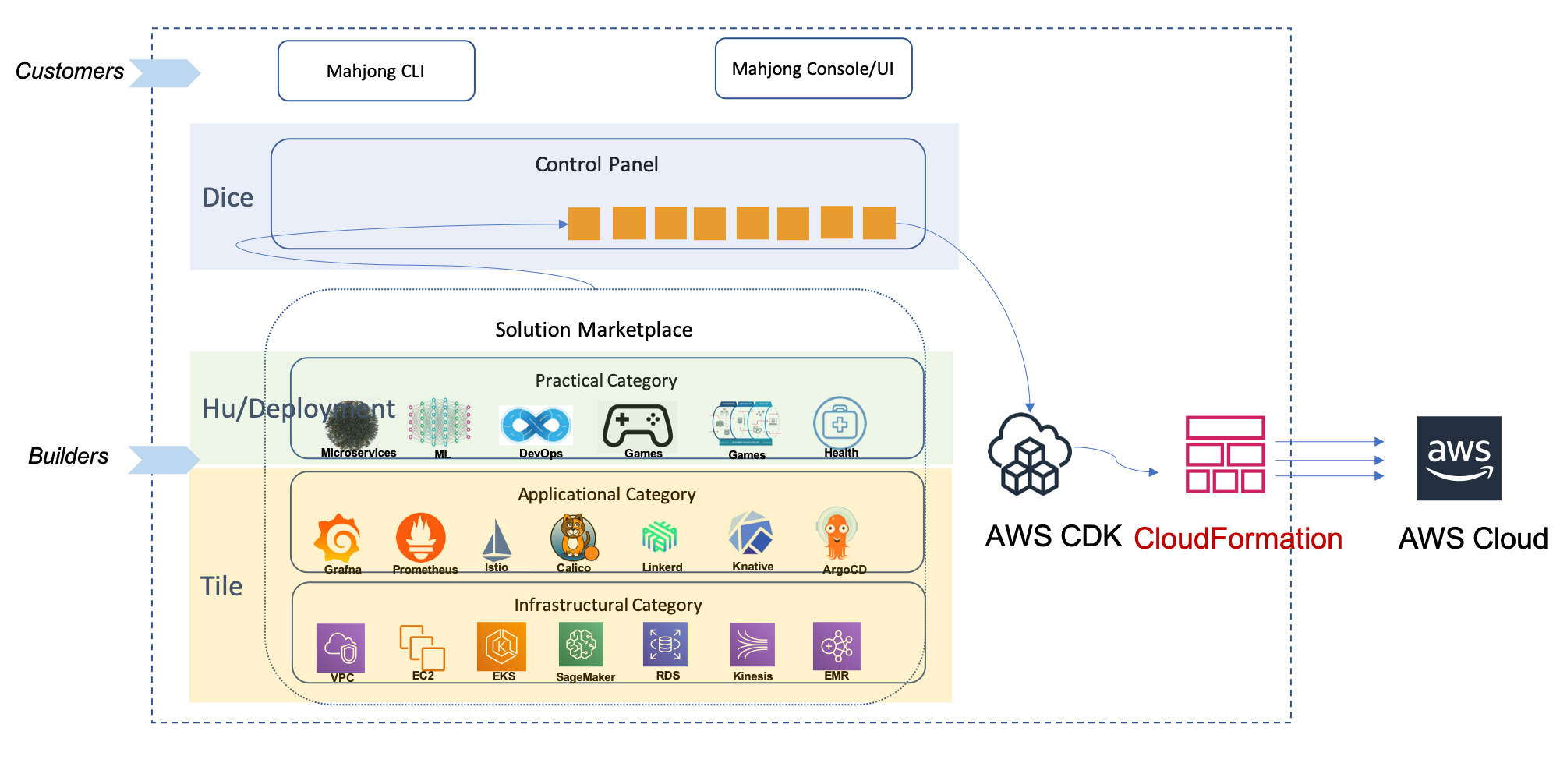Simple Usage
As you know, many of contributors have built best practices into Mahjong’s building blocks. We called it “tile”
In this case, we’re going to deploy a AWS EKS cluster
You only need to define your cluster name, nodes number, instance types and k8s version. Mahjong will help you to build cluster with minimal permission, cross AZ environment
Define and build service component
Know how to use Mahjong
Mahjong use Yaml to control deployment and tiles definition, including:
Tile
A building block, defined by YAML, represents a cloud component or a combination of multiple cloud components or resources. Tile is categorized by Network, ContainerProvider, Storage, Database, Application, ContainerApplication, Analysis, ML. Application and ContainerApplication are represented through commands and files, and rest of categories are represented through Construct::CDK
Deployment
A unit of deployment, defined by YAML, and all resources defined within the scope of Tiles.
“Hu”
A high level collection of deployment units, defined by YAML, represents a full solution and includes multiple Tiles with specific definition.

Define your EKS cluster
Now, let’s define your EKS cluster with a simple yaml file
create simple-eks.yaml
apiVersion: mahjong.io/v1alpha1
kind: Deployment
metadata:
name: simple-eks
version: 0.1.0
spec:
template:
tiles:
tileEks0005:
tileReference: Eks0
tileVersion: 0.0.5
inputs:
- name: clusterName
inputValue: mahjong-cluster101
- name: capacity
inputValue: 3
- name: capacityInstance
inputValue: m5.large
- name: version
inputValue: 1.16
summary:
description:
outputs:
- name: EKS Cluster Name
value: $(tileEks0005.outputs.clusterName)
- name: Master role arn for EKS Cluster
value: $(tileEks0005.outputs.masterRoleARN)
- name: The API endpoint EKS Cluster
value: $(tileEks0005.outputs.clusterEndpoint)
- name: Instance type of worker node
value: $(tileEks0005.outputs.capacityInstance)
- name: Default capacity of worker node
value: $(tileEks0005.outputs.capacity)
notes: []
Deploy it to AWS cloud
Run mctl deploy -f ./simple-eks.yaml
$ mctl deploy -f ./simple-eks.yaml
You will get the following output if everything works as expected
[ℹ] EKS Cluster Name = mahjong-cluster101
[ℹ] Master role arn for EKS Cluster = arn:aws:iam::638198787577:role/Eks0StacktileEks0005-Eks0EksClusterMasterRole76926-D9OV6NASDYGC
[ℹ] The API endpoint EKS Cluster = https://8F4AEE06CDA95AA5B9B82016B406F53B.gr7.us-east-2.eks.amazonaws.com
[ℹ] Instance type of worker node = m5.large
[ℹ] Default capacity of worker node = 3
Finish the deployment
Now your have finished AWS EKS deployment with Mahjong
Verification
Verify EKS
Once you have finished the deployment, you can check your cluster mahjong-cluster101
Find the master role in deployment logs
For example:
arn:aws:iam::638198787577:role/Eks0StacktileEks0005-Eks0EksClusterMasterRole76926-D9OV6NASDYGCRun
aws --region <region-code> eks update-kubeconfig --name <cluster_name> --role-arn arn:aws:iam::<aws_account_id>:role/<role_name>to save k8s logging configurationFor example:
aws --region us-east-2 eks update-kubeconfig--name mahjong-cluster101 --role-arn arn:aws:iam::638198787577:role/Eks0StacktileEks0005-Eks0EksClusterMasterRole76926-D9OV6NASDYGCInstall eksctl
curl --silent --location "https://github.com/weaveworks/eksctl/releases/latest/download/eksctl_$(uname -s)_amd64.tar.gz" | tar xz -C /tmp sudo mv /tmp/eksctl /usr/local/binInstall kubectl
curl -LO "https://storage.googleapis.com/kubernetes-release/release/$(curl -s https://storage.googleapis.com/kubernetes-release/release/stable.txt)/bin/darwin/amd64/kubectl" chmod +x ./kubectl sudo mv ./kubectl /usr/local/bin/kubectl kubectl version --clientCheck the cluster
$ kubectl get svc NAME TYPE CLUSTER-IP EXTERNAL-IP PORT(S) AGE kubernetes ClusterIP 172.20.0.1 <none> 443/TCP 4h41m
Use the EKS
Now let’s deploy a web game with the provisioned EKS cluster
create a file
2048.k8s.yamlapiVersion: v1 kind: Service metadata: name: my2048-service spec: ports: - port: 80 targetPort: 80 selector: app: my2048-k8s type: LoadBalancer --- apiVersion: apps/v1 kind: Deployment metadata: name: my2048-deployment spec: replicas: 2 selector: matchLabels: app: my2048-k8s template: metadata: labels: app: my2048-k8s spec: containers: - image: alexwhen/docker-2048 name: "my2048" ports: - containerPort: 80Run deployment
$ kubectl apply -f 2048.k8s.yamlCheck service status
$ kubectl get service/my2048-service NAME TYPE CLUSTER-IP EXTERNAL-IP PORT(S) AGE my2048-service LoadBalancer 172.20.88.7 a6ba48df2f1774376a8e065336c8bd44-1753238188.us-east-1.elb.amazonaws.com 80:31276/TCP 4d20hAccess your service
open your application endpoint in your browser
